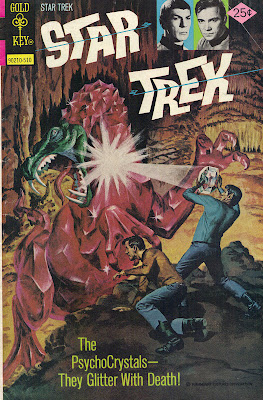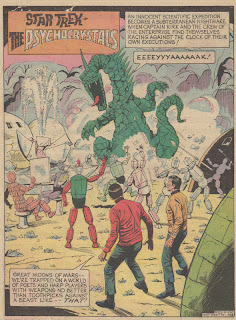 |
| Parodies by both Fred Hembeck and Don Martinec (above) pepper Chronicles. |
As National (Comic Book) Back Issue Month (NBIM) rolls on, and I reflect back on the titles I have thus far shared, it is more than a little surprising that I have yet to have posted about anything
with the Fantastic Four (FF) or written and/or drawn
by John Byrne--two of my all-time industry favorites. Like many, Byrne's run (starting first with breakdowns with issue #209 in 1979 and ending with issue #293 in 1986) on FF was both a gateway to comic book collecting and a high point.
 |
This cover, if net yet hanging
in a museum, shoudl be. |
During (and after) his FF work, I followed Byrne wherever he went wheter with Alpha Flight Volume 1 or to DC Comics Superman: Man of Steel reboot. I also stayed with the FF's various through various lurching starts, stops and start-up agains. I still collect FF, mostly out of affection for the past, and despite it's (to me) surprising recent success, have managed to be marginally engaged with the Hickman run. Maybe it's just that no one for me will ever create Fantastic Four adventures like
John Byrne.
The Fantastic Four Chronicles, released in 1982 by FantaCo Enterprises (with the permission of Marvel Comics), is a collection of articles, interviews and recollections by many of the key contributors to the Fantastic Four mythos up through FF issue #241. John Byrne's essay "The Fantastic Four: A Personal Recollection" is one of a number of high points, written during the middle of his legendary run.
In 1982, the $1.50 cover price was something of an investment for a 13 year-old but one I made for two reasons: it was about the FF, so why wouldn't I buy it? and the beautifully realized cover by Byrne which, to my childhood eyes, appeared to have been painted in way that dictated it's hanging in a museum. After purchasing it, I enjoyed the pictures (especially the series spanning centerfold by Byrne) and read different parts of each interview and article before placing it into a comic book bag for safe keeping.
Eventually, many years later, I returned to the issue and read it, as a college student, for what it was: an interesting exploration into the creative and editorial process, and further evidence that those involved with comic books do (and should) love comic books.
Fantastic Four Chronicles also includes interviews with Marv Wolfman, Len Wein, and others, while also offering a tribute to FF co-creator Jack "The King" Kirby. Toward the back, there is a cool "Fantastic Four Checklist" with to-date information about all things FF Marvel had published to date that surely fueled my collector fever by presenting comic books as archivable, lasting "things" to be savored, stored and shared.
While
Fantastic Four Chronicles is out of print, and may be difficult to come by (that is part of the fun, isn't it?), copies (and collections of FantaCo's Marvel "Chronicles" series (including Daredevil and The Avengers) are out there for the finding, and worth the effort if you are a fan.

























